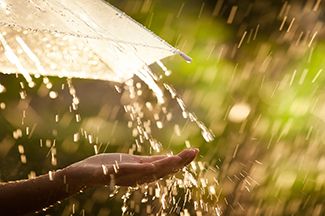Have you noticed a damp, musty smell or telltale black spots on your walls? Both are a sure sign that you have a mold problem in your home. And although mold is considered a year-round allergy, it can be particularly problematic this time of year. Damp, rainy weather followed by warmer temperatures are ideal conditions for mold to grow and thrive.
The Dangers of Mycotoxins
When it comes to mold, it’s not just the black spots you need to worry about. Mold produces millions of airborne spores that, when inhaled, can cause allergy-like symptoms. In the right conditions, certain types of molds also produce Mycotoxins. Although naturally occurring, Mycotoxins can be extremely dangerous for some individuals. They are associated with liver cancer and kidney failure; they can also damage the brain and central nervous system. For some people, the effects of mold can be life-changing.
Mold Wakes Up in The Spring
It’s also worth remembering that colder temperatures do not kill mold. So if you had a problem with mold last fall, those spores have been hanging around all winter, just waiting to wake up again as soon as the weather warms up.
How will I know I have mold toxicity?
Mold toxicity affects us all in different ways. Some people experience constant migraines and headaches, shortness of breath, brain fog, fatigue, or depression. This wide range of symptoms that differs from person to person can make mold toxicity challenging to spot. If you suspect you have mold poisoning, consult a medical professional who recognizes the symptoms of mold exposure and can order appropriate tests.
Track Down the Source
Before eliminating the mold, you must track down the source. Check for damaged pipes, leaks in the roof, old windows, or damaged gutters. Poorly ventilated bathrooms and basements, even dehumidifiers are often the perfect breeding ground for mold in your home.
Mold loves a warm, damp environment, and given the right conditions, it will happily eat away at various materials in your home if you let it.
It’s Time to Clean It Up!
When you’ve found the source of the mold, it must be safely removed. Some people use a combination of diluted bleach, vinegar, and borax to remove mold. Others prefer a bleach-free alternative, using just undiluted white vinegar (with a higher acidity than regular vinegar, of at least 5%) or essential oils such as tea tree or clove.
Please keep in mind mold and some of the products used to remove it can harmful to human health. So if you are sensitive to mold, have ongoing respiratory issues, such as asthma or allergies, or have a substantial amount of mold you may want to call an expert.
Don’t Forget the Air!
When the source of the mold has been dealt with, and any visible signs of mold have been removed, it’s time to think about your air quality. Mold releases millions of invisible spores into the surrounding air, which can significantly impact your health if they are not removed.
Keep The Air in Your Home Clean and Safe with the Austin Air Healthmate®
If you have experienced mold toxicity or are looking to improve air quality in your home, the Austin Air HealthMate® is our #1 best air purifier for damp environments. Using a combination of Medical Grade HEPA and carbon, the Austin Air HealthMate® will safely remove mold spores and Mycotoxins from the air.
For more information on keeping the air in your home clean, safe, and mold-free, read more HERE.
